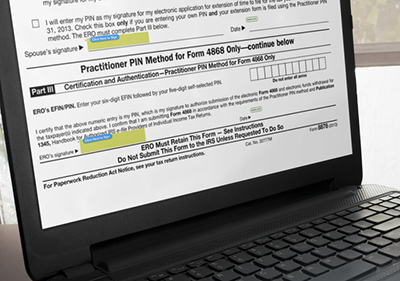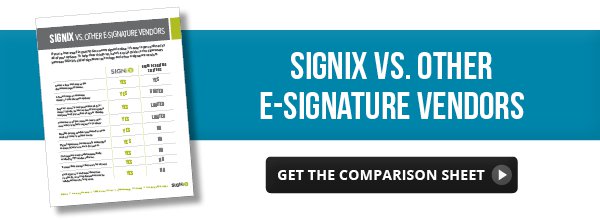SIGNiX’s digital signature products exceed newly published IRS standards for electronic signatures on forms 8878 and 8879 for e-filing tax returns.
CHATTANOOGA, Tenn.—March 13, 2014—SIGNiX, the leading provider of secure digital signatures, announced today that its products meet and exceed the Internal Revenue Service’s (IRS) electronic signature requirements for forms 8878 and 8879, which were published in a March 11 revision of Publication 1345.

The 8878 and 8879 forms authorize an Electronic Return Originator (ERO) to e-file tax returns to the IRS. In the past, only handwritten signatures or signatures captured on signature pads were accepted on these forms.
“Submitting your tax forms electronically means you can get your tax return faster than ever before,” said Jay Jumper, president and CEO of SIGNiX. “With the approval of electronic signatures on these forms, the process will be faster and easier for Electronic Return Originators and taxpayers alike.”
The IRS has created a set of requirements for electronic signatures on 8878 and 8879 forms:
- Identify the person who signed the document—If there is more than one taxpayer for the electronic record, the signature process must be designed to authenticate each taxpayer separately.
- Record the name, social security number, address and date of birth of the signer. The information given must be consistent with information provided through record checks with credit bureaus or similar databases.
- Get a handwritten signature if the signer fails the identity verification after three tries.
- Electronic signatures must be linked to the electronic record. The signatures should not be able to be removed, copied or transferred to falsify an electronic record.
- Documents must be tamper-proof. The electronic signature service must use techniques to lock a document and prevent it from being modified.
- Storage systems must have secure access control. Storage systems must also contain a retrieval system with an indexing system and the ability to reproduce legible hard copies of electronic records.
- Remote signers must be authenticated with knowledge-based authentication. The software must record that a signer successfully passed this form of authentication, per NIST requirements.
- The electronic signature software must record: The digital image of the signed form, the date and time of the signature, the taxpayer's computer IP address, the taxpayer’s login identification/user name, identify verification (the taxpayer’s knowledge based authentication passed results) and an audit trail that reflects the completion of the process by the signer. The ERO must keep this information on hand and be able to provide it to the IRS on request.
Taxpayers and EROs can easily and securely sign 8878 and 8879 forms using SIGNiX’s digital signature service, which fully complies with the IRS guidelines, the ESIGN Act and UETA laws regarding electronic signatures.
In fact, the IRS provides digital signatures, the technology used by SIGNiX, as a currently acceptable electronic signature method. SIGNiX can authenticate users online using a diverse set of tools, including multi-factor authentication. Each signature on SIGNiX-signed documents provides a tamper-evident seal for added security, and the included audit trail provides more information about the transaction than required by the IRS.
About SIGNiX
SIGNiX, the Global Digital Signature AuthorityTM, makes signing documents online safe and secure. SIGNiX offers the only independently verifiable cloud-based digital signature solution, which combines convenience with best-in-class security. SIGNiX’s products help the world’s leading companies become more efficient, decrease risk and boost profits. For more information, visit www.signix.com or follow SIGNiX on Twitter.
%20formatted-1.png?width=2528&height=739&name=SIGNiX%20Logo%20Main%20(white)%20formatted-1.png)

